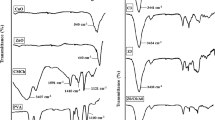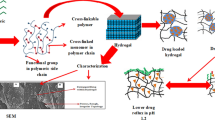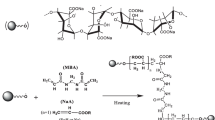Abstract
In this research, polyvinyl alcohol (PVA) was chemically cross-linked using epichlorohydrin (ECH). The nanocomposite hydrogels containing copper oxide nanoparticles (CuONPs) were synthesized through immersion of polyvinyl alcohol hydrogel in copper sulfate solution with different concentrations. The produced Cu2+ ions from copper sulfate were bound to hydroxyl groups via metal complexation. With the addition of NaOH solution, Cu2+ ions were converted to copper oxide nanoparticles. The morphology, surface investigation and identification of nanoparticles in polymer matrix were characterized using Fourier transform infrared spectroscopy, X-ray diffraction and scanning electron microscopy. Swelling properties of the prepared nanocomposite hydrogels were investigated with various solutions such as the urea, urine, d-glucose, salt solutions (CaCl2 and NaCl) and buffers (pH 1.2 and 7.4). Copper oxide nanoparticles led to an increase in swelling capacity of nanocomposite hydrogels. Indeed, loading and release behaviors of ibuprofen on nanocomposite hydrogels were studied.
Graphical abstract











Similar content being viewed by others
References
Hamidi M, Azadi A, Rafiei P (2008) Hydrogel nanoparticles in drug delivery. Adv Drug Deliv Rev 60(15):1638–1649
Yadollahi M, Gholamali I, Namazi H, Aghazadeh M (2015) Synthesis and characterization of antibacterial carboxymethylcellulose/CuO bio-nanocomposite hydrogels. Int J Biol Macromol 73:109–114
Yadollahi M, Namazi H, Aghazadeh M (2015) Antibacterial carboxymethyl cellulose/Ag nanocomposite hydrogels cross-linked with layered double hydroxides. Int J Biol Macromol 79:269–277. https://doi.org/10.1016/j.ijbiomac.2015.05.002
Namazi H, Rakhshaei R, Hamishehkar H, Kafil HS (2016) Antibiotic loaded carboxymethylcellulose/MCM-41 nanocomposite hydrogel films as potential wound dressing. Int J Biol Macromol 85:327–334
Gulrez SK, Al-Assaf S, Phillips GO (2011) Hydrogels: methods of preparation, characterisation and applications. In: Carpi A (ed) Progress in molecular and environmental bioengineering-from analysis and modeling to technology applications. InTech, London, pp 117–151. https://doi.org/10.5772/771
Amin S, Rajabnezhad S, Kohli K (2009) Hydrogels as potential drug delivery systems. Sci Res Essays 4(11):1175–1183
Rudzinski W, Dave A, Vaishnav U, Kumbar S, Kulkarni A, Aminabhavi T (2002) Hydrogels as controlled release devices in agriculture. Des Monomers Polym 5(1):39–65
Lee KY, Mooney DJ (2001) Hydrogels for tissue engineering. Chem Rev 101(7):1869–1880
Gao D, Heimann R, Lerchner J, Seidel J, Wolf G (2001) Development of a novel moisture sensor based on superabsorbent poly(acrylamide)-montmorillonite composite hydrogels. J Mater Sci 36(18):4567–4571
Namazi H, Jafarirad S (2011) Application of hybrid organic/inorganic dendritic ABA type triblock copolymers as new nanocarriers in drug delivery systems. Int J Polym Mater 60(9):603–619
Yadollahi M, Namazi H (2013) Synthesis and characterization of carboxymethyl cellulose/layered double hydroxide nanocomposites. J Nanopart Res 15(4):1563
Vashist A, Ahmad S (2013) Hydrogels: smart materials for drug delivery. Orient J Chem 29(3):861–870
Schexnailder P, Schmidt G (2009) Nanocomposite polymer hydrogels. Colloid Polym Sci 287(1):1–11
Muppalaneni S, Omidian H (2013) Polyvinyl alcohol in medicine and pharmacy: a perspective. J Dev Drugs 2(3):112–117. https://doi.org/10.4172/2329-6631.1000112
Patachia S, Rinja M, Isac L (2004) Some methods for doping poly(vinyl alcohol) hydrogels [PVA-HG]. Phys Chem 51:253–262
Bo J (1992) Study on PVA hydrogel crosslinked by epichlorohydrin. J Appl Polym Sci 46(5):783–786
Jiang S, Liu S, Feng W (2011) PVA hydrogel properties for biomedical application. J Mech Behav Biomed Mater 4(7):1228–1233
Sirousazar M, Yari M (2010) Dehydration kinetics of polyvinyl alcohol hydrogel wound dressings during wound healing process. Chin J Polym Sci 28(4):573–580
Kobayashi M, Hyu HS (2010) Development and evaluation of polyvinyl alcohol-hydrogels as an artificial atrticular cartilage for orthopedic implants. Materials 3(4):2753–2771
Hassan CM, Peppas NA (2000) Structure and applications of poly(vinyl alcohol) hydrogels produced by conventional crosslinking or by freezing/thawing methods. In: Biopolymers· PVA hydrogels, anionic polymerisation nanocomposites. Springer, pp 37–65
Lanje AS, Sharma SJ, Pode RB, Ningthoujam RS (2010) Synthesis and optical characterization of copper oxide nanoparticles. Adv Appl Sci Res 1(2):36–40
Swarnkar R, Singh S, Gopal R (2009) Synthesis of copper/copper-oxide nanoparticles: optical and structural characterizations. In: AIP Conference Proceedings, p 1147
Chang Y-N, Zhang M, Xia L, Zhang J, Xing G (2012) The toxic effects and mechanisms of CuO and ZnO nanoparticles. Materials 5(12):2850–2871
Wongpisutpaisan N, Charoonsuk P, Vittayakorn N, Pecharapa W (2011) Sonochemical synthesis and characterization of copper oxide nanoparticles. Energy Procedia 9:404–409
Ahmad Z, Vargas-Reus M, Bakhshi R, Ryan F, Ren G, Oktar F, Allaker R (2012) Antimicrobial properties of electrically formed elastomeric polyurethane–copper oxide nanocomposites for medical and dental applications. Methods Enzymol 509:87–99
Gouda M, Hebeish A (2009) Preparation and evaluation of CuO/chitosan nanocomposite for antibacterial finishing cotton fabric. J Ind Text 39:203–214. https://doi.org/10.1177/1528083709103142
Yadollahi M, Farhoudian S, Namazi H (2015) One-pot synthesis of antibacterial chitosan/silver bio-nanocomposite hydrogel beads as drug delivery systems. Int J Biol Macromol 79:37–43
Barkhordari S, Yadollahi M, Namazi H (2014) pH sensitive nanocomposite hydrogel beads based on carboxymethyl cellulose/layered double hydroxide as drug delivery systems. J Polym Res 21(6):1–9
Alpesh P, Kibret M (2011) Hydrogel biomaterials. In: Fazel PR (ed) Biomedical engineering—frontiers and challenges. In TeCH, London, pp 275–296. https://doi.org/10.5772/24856
Allen TM, Cullis PR (2004) Drug delivery systems: entering the mainstream. Science 303(5665):1818–1822
Yousef T, Hassan N (2017) Supramolecular encapsulation of doxorubicin with β-cyclodextrin dendrimer: in vitro evaluation of controlled release and cytotoxicity. J Incl Phenom Macrocycl Chem 87(1–2):105–115
Toomari Y, Namazi H (2016) Synthesis of supramolecular biodendrimeric β-CD-(spacer-β-CD) 21 via click reaction and evaluation of its application as anticancer drug delivery agent. Int J Polym Mater Polym Biomater 65(10):487–496
Bakravi A, Ahamadian Y, Hashemi H, Namazi H (2018) Synthesis of gelatin‐based biodegradable hydrogel nanocomposite and their application as drug delivery agent. Adv Polym Technol. https://doi.org/10.1002/adv.21938
Carlotti SJ, Giani-Beaune O, Schué F (2001) Water-soluble poly(vinyl alcohol) grafted with propylene oxide and epichlorohydrin: characterization, mechanical properties, and model reactions. J Appl Polym Sci 81(12):2868–2874
Bai X, Ye Z, Li Y, Ma Y (2010) Macroporous poly(vinyl alcohol) foam crosslinked with epichlorohydrin for microorganism immobilization. J Appl Polym Sci 117(5):2732–2739
Carbone K, Casarci M, Varrone M (1999) Crosslinked poly(vinyl alcohol) supports for the immobilization of a lipolytic enzyme. J Appl Polym Sci 74(8):1881–1889
Feng Q, Tang B, Wei Q, Hou D, Bi S, Wei A (2012) Preparation of a Cu(II)-PVA/PA6 composite nanofibrous membrane for enzyme immobilization. Int J Mol Sci 13(10):12734–12746
Mallakpour S, Dinari M, Azadi E (2015) Poly(vinyl alcohol) chains grafted onto the surface of copper oxide nanoparticles: application in synthesis and characterization of novel optically active and thermally stable nanocomposites based on poly(amide-imide) containing N-trimellitylimido-l-valine linkage. Int J Polym Anal Charact 20(1):82–97
Boroumand F, Moser JE, Van Den Bergh H (1992) Quantitative diffuse reflectance and transmittance infrared spectroscopy of nondiluted powders. Appl Spectrosc 46(12):1874–1886
Hemalatha K, Rukmani K, Suriyamurthy N, Nagabhushana B (2014) Synthesis, characterization and optical properties of hybrid PVA–ZnO nanocomposite: a composition dependent study. Mater Res Bull 51:438–446
Vicentini DS, Smania A, Laranjeira MC (2010) Chitosan/poly(vinyl alcohol) films containing ZnO nanoparticles and plasticizers. Mater Sci Eng C 30(4):503–508
Li W, Xue F, Cheng R (2007) Synthesis, characterization and swelling properties of a chemically cross-linked poly(vinyl alcohol) hydrogel. Front Chem China 2(2):188–192
Mansur HS, Oréfice RL, Mansur AA (2004) Characterization of poly(vinyl alcohol)/poly(ethylene glycol) hydrogels and PVA-derived hybrids by small-angle X-ray scattering and FTIR spectroscopy. Polymer 45(21):7193–7202
Yang C-C, Lin S-J, Hsu S-T (2003) Synthesis and characterization of alkaline polyvinyl alcohol and poly(epichlorohydrin) blend polymer electrolytes and performance in electrochemical cells. J Power Sources 122(2):210–218
Bhuiyan M, Saidur R, Amalina M, Mostafizur R, Islam A (2015) Effect of nanoparticles concentration and their sizes on surface tension of nanofluids. Procedia Eng 105:431–437
Ruiz J, Mantecon A, Cadiz V (2001) Synthesis and properties of hydrogels from poly(vinyl alcohol) and ethylenediaminetetraacetic dianhydride. Polymer 42(15):6347–6354
Cava R (1990) Structural chemistry and the local charge picture of copper oxide superconductors. Science 247(4943):656–662
Chang C, Duan B, Cai J, Zhang L (2010) Superabsorbent hydrogels based on cellulose for smart swelling and controllable delivery. Eur Polym J 46(1):92–100
Masuda Y, Okazaki Y, Nakanishi T (2002) Ion-specific swelling behavior of poly(vinyl alcohol) gel in aqueous solutions containing some divalent ions. Colloid Polym Sci 280(9):873–875
Hosseinzadeh H (2013) Synthesis and swelling properties of a poly(vinyl alcohol)-based superabsorbing hydrogel. Curr Chem Lett 2(3):153–158
Varshosaz J, Koopaie N (2002) Cross-linked poly(vinyl alcohol) hydrogel: study of swelling and drug release behaviour. Iran Polym J 11:123–131
Acknowledgements
Authors gratefully acknowledge the financial support of ‘Excellence center for Clean Chemistry and New Materials’ the University of Tabriz, and ‘Research Center for Pharmaceutical Nanotechnology (RCPN) of Medical Science’ in Tabriz University.
Author information
Authors and Affiliations
Corresponding author
Rights and permissions
About this article
Cite this article
Ahmadian, Y., Bakravi, A., Hashemi, H. et al. Synthesis of polyvinyl alcohol/CuO nanocomposite hydrogel and its application as drug delivery agent. Polym. Bull. 76, 1967–1983 (2019). https://doi.org/10.1007/s00289-018-2477-9
Received:
Revised:
Accepted:
Published:
Issue Date:
DOI: https://doi.org/10.1007/s00289-018-2477-9




